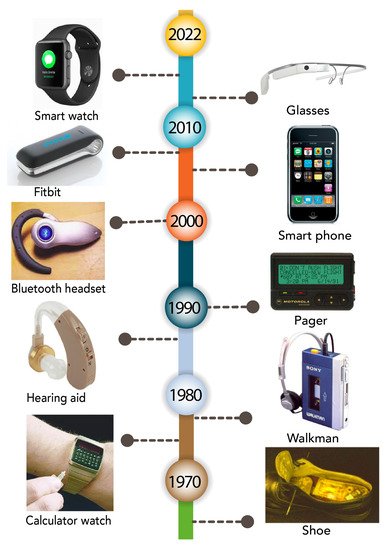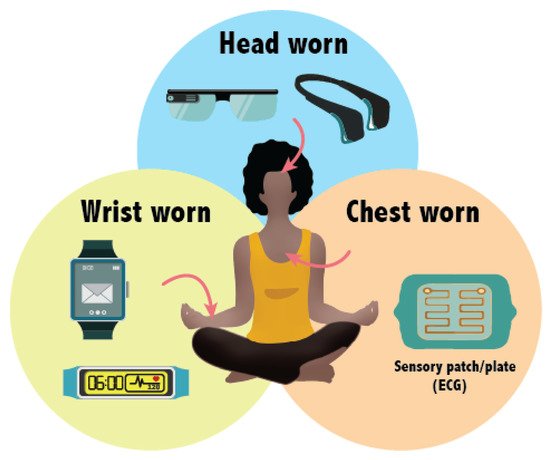You're using an outdated browser. Please upgrade to a modern browser for the best experience.
Please note this is an old version of this entry, which may differ significantly from the current revision.
Subjects:
Engineering, Manufacturing
Wearable sensors have traditionally been used to measure and monitor vital human signs for well-being and healthcare applications. However, there is a growing interest in using and deploying these technologies to facilitate teaching and learning, particularly in a higher education environment.
- wearable sensors
- engineering education
- technology enhanced learning
1. History of Wearable Technology
The first wearable was a cigarette pack sized timing device, which was hidden in shoes (Figure 2) and invented in 1955. The device was designed to predict roulette wheels in casinos and was publicly introduced in 1966 [34]. Since then, Wearable devices have evolved into various forms of accessories, watches, headsets, phones and glasses, as shown in Figure 2.

Figure 2. Development of wearable devices during the past 50 years. Starting from 1960s, the first wearable product was a centimeter-scale computer hidden inside shoes. Currently, advanced millimeter-scale systems are embedded on wrist-worn, chest-worn and head-worn platforms.
In the mid-1970s, the wearable industry and market began to grow, thanks to the introduction of calculator watches [35]. By the end of the 1970s, this market significantly expanded to the entertainment sector via the introduction of the Sony Walkman cassette player. It also expanded to the workplace via the introduction of pager devices in the 1990s. However, the boom in wearable technology only took off in 2010, thanks to the introduction of casino data bank watches [11].
2. Wearable Sensors for Psychophysiological Measures
The common psychophysiological assessment methods are:
-
Electrocardiography (ECG): ECG records the electrical signals in the heart, which are often used to measure and diagnose abnormal heart rhythm. It has been widely used in basic and clinical research. Meanwhile, electrocardiogram holds an important position in psychological research. The current psychophysiological evidence shows that heart rate is affected by external stress in most cases, so its use in the objective evaluation of psychological stress can be proved [36].
-
Electromyography (EMG): EMG measurement has been proved to be useful for studying mental load, muscle mental tension and emotions, especially facial expressions. There is a strong correlation between EMG signals and emotion changes [37]. When the mood is more pleasant, the muscles will relax, and the EMG signal will become lower. When the mood changes to an unhappy state, the muscles begin to tighten, and the myoelectric signal becomes high.
-
Galvanic Skin Response (GSR): Human organs are controlled by the sympathetic and parasympathetic nervous systems under the autonomic nervous system. However, the skin is an exception to the above statement because it is completely dominated by the sympathetic nervous system [38]. Therefore, the electrodermal activity can better reflect the psychological state of people when they are stimulated by the outside world. GSR measures by skin conductance data due to skin conductance is directly proportional to sweat secretion [39]. That makes the skin conductivity an ideal indicator to measure the activation of the sympathetic nervous system.
-
Electroencephalography (EEG): EEG is a physiological monitoring method for recording brain waves. The specific method is to use a small metal disk (electrode) attached to the scalp to detect the voltage fluctuation generated by the ion current in the brain. It measures the synchronous sum of postsynaptic potentials when pyramidal cells are excited. Recently, EEG method has been widely used in psychological research because of its unique advantages, which ensures the scientific nature and objectivity of psychological research [40].
-
Functional Near-infrared Spectroscopy (fNIRS): fNIRS is a method of optically monitoring the brain that does functional neuroimaging using near-infrared spectroscopy. It can be used to calculate the cortical hemodynamic response to brain activity. Along with EEG, fNIRS is one of the most popular non-invasive neuroimaging methods that can be applied in mobile settings. Because fNIRS has limited depth in detecting cerebral cortex [41], researchers pay more attention to the role of prefrontal cortex in emotional processing [42].
3. Market of Wearable Technology for Education
The education technology (edtech) is a multi-trillion dollar industry [43] that is growing each year. Many countries in the Organisation for Economic Co-operation and Development (OECD) are devoting more than 10% of their public spending on education [44]. The emergencies (e.g., COVID-19 pandemic over last year) have often been a catalyst for reform in many divisions, including education [45]. The COVID-19 stimulated educational organisations to implement hybrid or fully remote schooling based on emerging edtech. Such digital technologies (e.g., video conferencing tools, or online learning management software to be used on portable laptop, tablet and smartphone) usually occur within years, while due to the pandemic circumstances and physical teaching limitations, they progressed within months [46].In future, in case of any lock-downs like pandemics the edtech require to provide full remote learning and teaching.
Furthermore, public spending on edtech is projected to increase as more countries increase their public spending on education. For example, low- and middle-income countries plan to increase spending on education from the current US$1.2 trillion per year to US$3 trillion [47]. As mentioned in the Incheon Declaration, countries need to allocate at least 4% to 6% of their gross domestic product (GDP) on education; and/or allocate at least 15% to 20% of public expenditure to education [48].
In addition to this projected growth in the educational sector, the wearable technology market is growing sharply and is strongly correlated with advances in globally connected devices. These are predicted to increase from 593 million devices in 2018 to 929 million devices by 2021 [49]. In 2020, the wearables market was estimated to be worth 5 billion dollar [50].
In 2020, Vandrico INC compiled a database of companies and wearable products. According to their research, there were 266 registered companies, which have produced 431 different wearable products [51]. They also divided wearables according to 7 different categories, which were: Entertainment, Fitness, Gaming, Industrial, Lifestyle, Medical and Pets. None of these categories included education, despite the literature showing a clear use of wearables in this field.
4. Education
Creative undergraduate and postgraduate courses that rely on active learning methods are required to meet the needs of new technologies such as wearables [58,59,60]. According to Statista and the National Purchase Diary Panel Inc (NPD Group), wearable devices are popular among the younger generation, typically those aged between 18 and 39 [61,62]. Therefore, in recent years, universities have been interested in introducing wearable devices in their educational curricula [63]. Despite the rapid growth in using wearable devices in healthcare, entertainment and other applications, using wearables for education are still in their infancy.
Wearable devices can be worn on different body parts such as the head, neck, chest, torso, waist, shoulders, arm, wrist, hand, finger, legs and feet. The majority of existing devices are worn on the wrist and are mainly used for fitness purposes. Wearer comfort and familiarity could be the reason for their success. Furthermore, wearable devices such as head-mounted displays, smart glasses and smartwatches were proven beneficial for educational purposes. The locations of these wearable devices on the body is shown in Figure 1. In fact, these devices were used for different educational activities such as medical training, student engagement and authentic learning.

Figure 1. Classified wearable sensors for educational purposes according to three major categories according to their placement. They can be worn on the head, wrist or chest to collect and monitor information from students and teachers.
This entry is adapted from the peer-reviewed paper 10.3390/s22197633
This entry is offline, you can click here to edit this entry!
